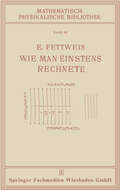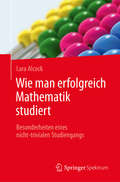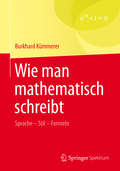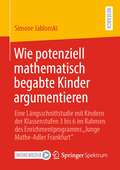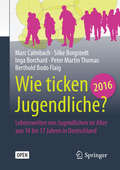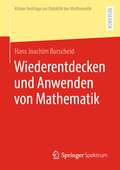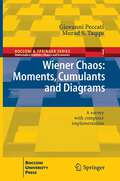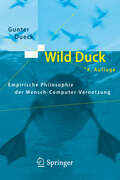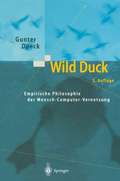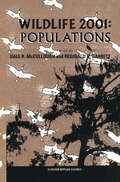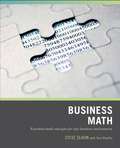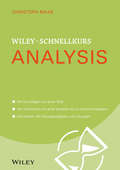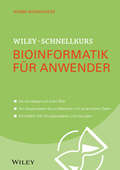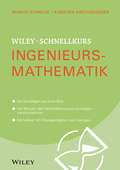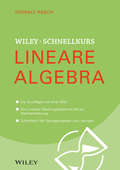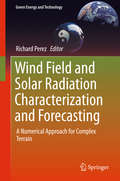- Table View
- List View
Wie Man Einstens Rechnete (Mathematisch-physikalische Bibliothek)
by Ewald FettweisDieser Buchtitel ist Teil des Digitalisierungsprojekts Springer Book Archives mit Publikationen, die seit den Anfängen des Verlags von 1842 erschienen sind. Der Verlag stellt mit diesem Archiv Quellen für die historische wie auch die disziplingeschichtliche Forschung zur Verfügung, die jeweils im historischen Kontext betrachtet werden müssen. Dieser Titel erschien in der Zeit vor 1945 und wird daher in seiner zeittypischen politisch-ideologischen Ausrichtung vom Verlag nicht beworben.
Wie man erfolgreich Mathematik studiert: Besonderheiten eines nicht-trivialen Studiengangs
by Lara Alcock Bernhard GerlDieses Buch bietet praxisorientierte Hilfestellungen und fachspezifische Ratschläge für Studienanfänger der Mathematik und ihrer Anwendungsgebiete. Es handelt von den Eigenheiten der höheren Mathematik sowie der damit verbundenen Arbeits- und Denkweise, geht aber auch auf allgemeinere Herausforderungen des Studiums ein: Erläutert werden – neben zentralen Begriffen und Herangehensweisen der Mathematik – unter anderem die effektive Nutzung der zur Verfügung stehenden Zeit und der Umgang mit abstrakten intellektuellen Herausforderungen. Vielfältige Hinweise erleichtern es, mit der Schwerpunktverschiebung vom Rechnen zum Beweisen kompetent umzugehen, im Studium den Überblick zu behalten, selbstständig und nachhaltig zu lernen sowie die Begeisterung für das Fach nicht zu verlieren. Dies schafft optimale Rahmenbedingungen für eine erfolgreiche Auseinandersetzung mit der Mathematik.
Wie man mathematisch schreibt: Sprache – Stil – Formeln
by Burkhard KümmererSie studieren Mathematik und schreiben eine Bachelor- oder Masterarbeit? Sie schreiben eine Seminararbeit oder gar ein mathematisches Buch? Am Ende hängt der Erfolg Ihrer Arbeit davon ab, ob Sie Ihre Gedanken verständlich und ansprechend zu Papier bringen, in gutem Stil also. Guten Stil erkennt man sofort. Die Wege zu gutem Stil aber sind etwas länger und werfen viele Fragen auf: Wie wird eine Formel übersichtlich und wie nummeriert man am besten? Wie findet man gute Bezeichnungen für mathematische Objekte und wo führt man sie ein? Wie sieht ein gut geschriebener Beweis aus? Welche Literatur sollte man besser nicht zitieren und für wen schreibt man eigentlich eine Bachelorarbeit? Diese Fragen und viele mehr beantwortet dieser zuverlässige Begleiter. Die Antworten werden in übersichtlichen Regeln und Hinweisen zusammengefasst. Alle Fragen zur Gestaltung werden auch in LaTeX beantwortet und ein ausführlicher Anhang stellt sämtliche mathematikbezogene LaTeX-Anweisungen nach Themen geordnet zusammen.
Wie potenziell mathematisch begabte Kinder argumentieren: Eine Längsschnittstudie mit Kindern der Klassenstufen 3 bis 6 im Rahmen des Enrichmentprogramms „Junge Mathe-Adler Frankfurt“
by Simone JablonskiIn einer qualitativen Längsschnittstudie untersucht Simone Jablonski Veränderungen beim mündlichen Argumentieren von potenziell mathematisch begabten Kindern. Dazu entwickelt sie ein Analyseschema, das die Kategorien Struktur, Inhalt, Gültigkeit, Schlussweise und Eigenständigkeit berücksichtigt. Mithilfe aufgabenbasierter Interviews aus dem Bereich der Arithmetik werden 37 Kinder der Klassenstufen 3 bis 6 über anderthalb Jahre wiederholt befragt. Die Analyse der dabei entstandenen Argumentationsprodukte ergibt sechs verschiedene Argumentationstypen, die die Veränderungen beim Argumentieren einerseits und die Unterschiede zwischen den Kindern andererseits deutlich machen. Letztlich können auf Basis der gebildeten Typen Konsequenzen für die Förderung mathematisch begabter Kinder abgeleitet werden.
Wie ticken Jugendliche 2016?: Lebenswelten von Jugendlichen im Alter von 14 bis 17 Jahren in Deutschland
by Marc Calmbach Silke Borgstedt Inga Borchard Peter Martin Thomas Berthold Bodo FlaigDieses Buch ist eine Open-Access-Publikation unter einer CC BY-NC 2.5 Lizenz.Wie leben und erleben Jugendliche ihren Alltag? Wie nehmen sie die historischen und heutigen Verhältnisse in Deutschland und in der Welt wahr? Was stiftet für sie Sinn? Welche Lebensentwürfe verfolgen sie? Welche Rolle spielen Mobilität, Nachhaltigkeit und digitale Medien in ihrem Leben?Diesen und weiteren Fragen geht die SINUS-Jugendstudie 2016 empirisch nach und bildet dabei die Vielfalt der Perspektiven jugendlicher Lebenswelten ab. Das gelingt ihr besonders anschaulich, indem sie 14- bis 17-Jährige in Form von zahlreichen Zitaten und kreativen Selbstzeugnissen ungefiltert zu Wort kommen lässt. Einzigartig ist auch, dass Jugendliche fotografische Einblicke in ihre Wohnwelten gewähren und erstmalig selbst als Interviewer ihre Fragen eingebracht haben. Die SINUS-Jugendstudie verleiht der jungen Generation somit eine öffentliche Stimme, die es genau wahrzunehmen gilt. Denn der Blick auf die Jugend ist immer auch ein Blick auf die Zukunft eines Landes. Nach den Vorgängerstudien (2008, 2012) legt das SINUS-Institut bereits die dritte Untersuchung der viel beachteten Reihe „Wie ticken Jugendliche?“ vor.
Wiederentdecken und Anwenden von Mathematik (Kölner Beiträge zur Didaktik der Mathematik)
by Hans Joachim BurscheidDas Buch wirft die Frage auf, ob das von Hans Freudenthal formulierte Prinzip des „Wiederentdeckens von Mathematik“ in ein formales Konzept eingebunden werden kann. Zur Begründung des vorgeschlagenen Konzeptes der „empirischen Theorie“ wird die Frage auch unter historischem Aspekt betrachtet. Der im Jahre 1990 u. a. vom Autor eingeführte Begriff der „didaktischen Konzeption“ wird ebenfalls aufgegriffen.Erwirbt man Mathematik im Rahmen empirischer Theorien, so erhält das Anwenden von Mathematik eine besondere Bedeutung. Dessen Verständnis innerhalb der Mathematikdidaktik wird diskutiert.
Wiener Chaos: A survey with Computer Implementation (Bocconi & Springer Series #1)
by Giovanni Peccati Murad S. TaqquThe concept of Wiener chaos generalizes to an infinite-dimensional setting the properties of orthogonal polynomials associated with probability distributions on the real line. It plays a crucial role in modern probability theory, with applications ranging from Malliavin calculus to stochastic differential equations and from probabilistic approximations to mathematical finance. This book is concerned with combinatorial structures arising from the study of chaotic random variables related to infinitely divisible random measures. The combinatorial structures involved are those of partitions of finite sets, over which Möbius functions and related inversion formulae are defined. This combinatorial standpoint (which is originally due to Rota and Wallstrom) provides an ideal framework for diagrams, which are graphical devices used to compute moments and cumulants of random variables. Several applications are described, in particular, recent limit theorems for chaotic random variables. An Appendix presents a computer implementation in MATHEMATICA for many of the formulae.
Wild Duck: Empirische Philosophie der Mensch-Computer-Vernetzung
by Gunter DueckWussten Sie, dass Menschen am besten arbeiten, wenn sie Sinn und Herausforderung in ihrer Tätigkeit sehen? Jeder weiß das, aber unsere Erziehungs- und Managementsysteme bauen darauf, dass Lernen, Arbeit und Fortkommen Mühsal sind. Der Autor wagt die Prognose, dass die Computer der Zukunft erzwingen werden, dass Arbeit Spaß macht. Das Buch, provozierend und atemberaubend querdenkend geschrieben, hält stilistisch eine Balance zwischen Ironie, Scharfrichterernst, Satire und philosophischer Ruhe. Die 4. Auflage wurde um ein Nachwort des Autors ergänzt.
Wild Duck: Empirische Philosophie der Mensch-Computer-Vernetzung
by Gunter DueckEin Buch mit echtem Wow!-Effekt. Provozierend, atemberaubend querdenkend über wichtige Themen, die uns zum Teil nicht einmal in den Sinn kommen. Spannend geschrieben, teils sanft, mal bitterböse, immer witzig-brillant: Vorsicht, langsam lesen und genießen - nichts verpassen! Es hält eine merkwürdige Balance zwischen Ironie, Scharfrichterernst, Slapstickeinlage, Satire und philosophischer Ruhe. Wir schwanken: "Das stimmt genau." - "Ist das wirklich ernst gemeint?" - "Das darf man so nicht sagen!" Wußten Sie schon, daß Menschen am besten und erfolgreichsten arbeiten, wenn sie Sinn und Herausforderung in ihrer Tätigkeit sehen, wenn sie in ihr Erfüllung und Freude finden? Jeder von uns weiß das, aber unsere Erziehungs- und Managementsysteme sind erst zufrieden, wenn Lernen und Lehren, Arbeit und Fortkommen Mühsal sind. Der Autor wagt die provozierende Prognose: Die kontrollierenden Computer der Zukunft werden erzwingen, daß Arbeit Spaß macht.
Wildlife 2001: Populations
by D. R. McCullough R. H. BarrettIn 1984, a conference called Wildlife 2000: Modeling habitat relationships of terrestrial vertebrates, was held at Stanford Sierra Camp at Fallen Leaf Lake in the Sierra Nevada Mountains of California. The conference was well-received, and the published volume (Verner, J. , M. L. Morrison, and C. J. Ralph, editors. 1986. Wildlife 2000: modeling habitat relationships of terrestrial vertebrates, University of Wisconsin Press, Madison, Wisconsin, USA) proved to be a landmark publication that received a book award by The Wildlife Society. Wildlife 2001: populations was a followup conference with emphasis on the other major biological field of wildlife conservation and management, populations. It was held on July 29-31, 1991, at the Oakland Airport Hilton Hotel in Oakland, California, in accordance with our intent that this conference have a much stronger international representation than did Wildlife 2000. The goal of the conference was to bring together an international group of specialists to address the state of the art in wildlife population dynamics, and set the agenda for future research and management on the threshold of the 21st century. The mix of specialists included workers in theoretical, as well as practical, aspects of wildlife conservation and management. Three general sessions covered methods, modelling, and conservation of threatened species.
Wiley Pathways Business Math
by Steve Slavin Tere StoufferYou can get there Where do you want to go? You might already be working in a business setting. You may be looking to expand your skills. Or, you might be setting out on a new career path. Wherever you want to go, Business Math will help you get there. Easy-to-read, practical, and up-to-date, this text not only helps you learn fundamental mathematical concepts needed for business, it also helps you master the core competencies and skills you need to succeed in the classroom and beyond. The book's brief, modular format and variety of built-in learning resources enable you to learn at your own pace and focus your studies. With this book, you will be able to: * Understand the business uses of percent calculations. * Solve business problems using algebraic equations. * Learn why stores markup and markdown their inventory. * Calculate different types of discounts. * Examine different banking options. * Compare personal, sales, and property taxes and the implications of taxing income, property, and retail sales. * Calculate simple and compound interest and learn how each affects the future value of money. * Explore the uses of promissory notes, mortgages, and credit cards and how to calculate the cost of each. * Learn different ways to determine the loss of value of business property and equipment, and the effect of depreciation on taxes. * Examine financial statements and learn how to read the income statement and the balance sheet. * Learn how to calculate the mean, median, mode, and range of data. Wiley Pathways helps you achieve your goals When it comes to learning about business, not everyone is on the same path. But everyone wants to succeed. The new Wiley Pathways series in Business helps you achieve your goals with its brief, inviting format, clear language, and focus on core competencies and skills. The books in this series--Finance, Business Communication, Marketing, Business Math, and Real Estate--offer a coordinated curriculum for learning business. Learn more at www.wiley.com/go/pathways.
Wiley-Schnellkurs Analysis (Wiley Schnellkurs)
by Christoph MaasOb in Wirtschafts-, Natur-, oder Ingenieurswissenschaften, sobald Sie sich mit Mathematik beschäftigen müssen, kommen Sie an der Analysis nicht vorbei. Leider wird die ab einem gewissen Niveau recht abstrakt und ist auf Anhieb nicht immer leicht zu verstehen. Christoph Maas erklärt Ihnen in diesem Buch zügig, was Sie über Analysis wissen sollten: von Funktionen mit einer oder mehreren Variablen, über Ableitungen bis zu Integralen. Mit zahlreichen Beispielen und Übungsaufgaben mit Lösungen können Sie Ihr Wissen testen und festigen. So hilft Ihnen dieses Buch besonders, wenn es etwas mehr als die übliche Schulmathematik sein soll.
Wiley-Schnellkurs Bioinformatik für Anwender (Wiley Schnellkurs)
by Röbbe WünschiersDie digitale Datenverarbeitung wird auch für Lebenswissenschaftler immer wichtiger. Hier setzt dieser Schnellkurs an. Röbbe Wünschiers erklärt Ihnen, wie Sie mit Sequenz-, Struktur- und anderen Daten umgehen sollten. Er erläutert, wie Sie Linux als virtuelle Maschine installieren und wie Ihnen Linuxtools wie Sed oder die einfache Programmiersprache AWK bei der Datenanalyse helfen können. Außerdem führt er Sie knapp in weitere Bereiche ein, die Ihnen das digitale Leben erleichtern können: das Datenbanksystem MariaDB/MySQL, die Programmierumgebung R für statistisches Rechnen und Datenvisualisierung, die Textsatzsprache LaTeX und einiges mehr. Ausgearbeitete Beispiele aus den Lebenswissenschaften und Übungsaufgaben samt Lösungen helfen Ihnen Ihr Wissen zu festigen und zu überprüfen. Auf der Webseite datenmassen.de finden sich alle Daten und Abbildungen zum Download.
Wiley-Schnellkurs Ingenieursmathematik (Wiley Schnellkurs)
by Marco Schreck Karsten KirchgessnerMathematik ist ein zentraler Bestandteil in der Ausbildung von Ingenieuren und Technikern. Leider sind von der Schulzeit her oft nur rudimentäre Ansätze vorhanden. Genau für diese Leser haben Marco Schreck und Karsten Kirchgessner dieses Buch geschrieben. Sie geben Ihnen eine kurze Einführung in Differenzial- und Integralrechnung, komplexe Zahlen, Vektoren und Matrizen, analytische Geometrie und vieles mehr. Viele Übungsaufgaben mit Lösungen helfen Ihnen, Ihr Wissen zu festigen und zu prüfen. So hilft Ihnen das Buch bei Ihrem Start in die Ingenieursmathematik, oder wenn Sie Ihr Wissen mehr in der Breite als in der Tiefe wieder auffrischen müssen. Schnell lernen: Der Einstiegstest: So überprüfen Sie Ihr Wissen und verbessern es gezielt. Die Lerntipps: So profitieren Sie von der Lehrerfahrung der Autoren. Die Übungsaufgaben mit Lösungen: So überprüfen und festigen Sie Ihr Wissen.
Wiley-Schnellkurs Lineare Algebra (Wiley Schnellkurs)
by Thoralf RäschSie ist nicht beliebt und manchmal schwer zu verstehen: die Lineare Algebra. Aber keine Sorge: Thoralf Räsch hat ein kompaktes und verständliches Buch geschrieben, das Ihnen hilft, die Grundlagen der Linearen Algebra zu verstehen. Er erklärt Ihnen, was Sie über die algebraischen Grundlagen, Vektorräume, Lineare Gleichungssysteme und Matrizen wissen sollten. Auch die komplexen Zahlen kommen nicht zu kurz. Übungsaufgaben und Lösungen helfen Ihnen, Ihr Wissen zu festigen und zu überprüfen. So hilft Ihnen dieses Buch beim Grundverständnis der Linearen Algebra, wenn es einmal schnell gehen soll.
Wiley-Schnellkurs Lineare Algebra II (Wiley Schnellkurs)
by Thoralf RäschBei etwas komplizierteren Fragestellungen kommen Sie oft mit den Grundlagen der Linearen Algebra nicht weiter. Hier hilft Ihnen dieses Buch. Thoralf Räsch erklärt Ihnen zu Beginn ganz knapp die Grundlagen, geht dann aber schnell weiter zu Koordinatentransformation, Eigenwerten und Eigenvektoren. Er erläutert zudem Determinanten von Matrizen, euklidische Vektorräume, Definiertheit von Matrizen und vieles mehr. Mit Übungsaufgaben samt Lösungen können Sie Ihr Wissen testen und festigen.
Wiley-Schnellkurs Statistik (Wiley Schnellkurs)
by Reiner KurzhalsEs gibt nur wenige Studiengänge, in denen Sie an der Statistik vorbeikommen. Statistik gilt zudem als anspruchsvoll und sehr lernintensiv, aber Sie können auch zu sehr spannenden Ergebnissen kommen. Reiner Kurzhals erklärt Ihnen so knapp und verständlich wie möglich, was Sie über Statistik wissen müssen. Er erläutert neben den Grundbegriffen die wichtigsten Punkte der beschreibenden und der schließenden Statistik. Viele Beispiele helfen Ihnen dabei, sich die abstrakten Formeln und Begriffe besser vorstellen zu können. Mit den zahlreichen Übungsaufgaben mit Lösungen können sie Ihr Wissen festigen und prüfen.
Wiley-Schnellkurs Wirtschaftsmathematik (Wiley Schnellkurs)
by Jürgen FaikWirtschaftsmathematik: Das hört sich erst einmal nicht spannend an, aber Mathematik hilft Ihnen, viele wichtige Themen zu verstehen und Zusammenhänge zu ermitteln. Außerdem muss man hier meist eine Klausur schreiben. Jürgen Faik gibt Ihnen eine schnelle Einführung und einen verständlichen Überblick über die Wirtschaftsmathematik. Er beginnt bei den Grundlagen wie Rechenregeln, Gleichungen, Folgen, Reihen und Funktionen. Dann erklärt er Ihnen, was Sie zu Differential- und Integralrechnung wissen müssen. Er erläutert das Wichtigste zur Linearen Algebra und zuletzt hilft er Ihnen bei Ihren ersten Schritten in der Finanzmathematik. Mit vielen Übungsaufgaben samt Lösungen können Sie sich selbst testen und Ihr Wissen festigen.
Will You Be Alive 10 Years from Now?: And Numerous Other Curious Questions in Probability
by Paul J. NahinWhat are the chances of a game-show contestant finding a chicken in a box? Is the Hanukkah dreidel a fair game? Will you be alive ten years from now? These are just some of the one-of-a-kind probability puzzles that acclaimed popular math writer Paul Nahin offers in this lively and informative book. Nahin brings probability to life with colorful and amusing historical anecdotes as well as an electrifying approach to solving puzzles that illustrates many of the techniques that mathematicians and scientists use to grapple with probability. He looks at classic puzzles from the past--from Galileo's dice-tossing problem to a disarming dice puzzle that would have astonished even Newton--and also includes a dozen challenge problems for you to tackle yourself, with complete solutions provided in the back of the book. Nahin then presents twenty-five unusual probability puzzlers that you aren't likely to find anywhere else, and which range in difficulty from ones that are easy but clever to others that are technically intricate. Each problem is accompanied by an entertaining discussion of its background and solution, and is backed up by theory and computer simulations whenever possible in order to show how theory and computer experimentation can often work together on probability questions. All the MATLAB® Monte Carlo simulation codes needed to solve the problems computationally are included in the book.With his characteristic wit, audacity, and insight, Nahin demonstrates why seemingly simple probability problems can stump even the experts.
Will You Be Alive 10 Years from Now?: And Numerous Other Curious Questions in Probability
by Paul J. NahinWhat are the chances of a game-show contestant finding a chicken in a box? Is the Hanukkah dreidel a fair game? Will you be alive ten years from now? These are just some of the one-of-a-kind probability puzzles that acclaimed popular math writer Paul Nahin offers in this lively and informative book. Nahin brings probability to life with colorful and amusing historical anecdotes as well as an electrifying approach to solving puzzles that illustrates many of the techniques that mathematicians and scientists use to grapple with probability. He looks at classic puzzles from the past--from Galileo's dice-tossing problem to a disarming dice puzzle that would have astonished even Newton--and also includes a dozen challenge problems for you to tackle yourself, with complete solutions provided in the back of the book. Nahin then presents twenty-five unusual probability puzzlers that you aren't likely to find anywhere else, and which range in difficulty from ones that are easy but clever to others that are technically intricate. Each problem is accompanied by an entertaining discussion of its background and solution, and is backed up by theory and computer simulations whenever possible in order to show how theory and computer experimentation can often work together on probability questions. All the MATLAB® Monte Carlo simulation codes needed to solve the problems computationally are included in the book.With his characteristic wit, audacity, and insight, Nahin demonstrates why seemingly simple probability problems can stump even the experts.
Willful Ignorance: The Mismeasure of Uncertainty
by Dr. Herbert I. WeisbergAn original account of willful ignorance and how this principle relates to modern probability and statistical methods Through a series of colorful stories about great thinkers and the problems they chose to solve, the author traces the historical evolution of probability and explains how statistical methods have helped to propel scientific research. However, the past success of statistics has depended on vast, deliberate simplifications amounting to willful ignorance, and this very success now threatens future advances in medicine, the social sciences, and other fields. Limitations of existing methods result in frequent reversals of scientific findings and recommendations, to the consternation of both scientists and the lay public. Willful Ignorance: The Mismeasure of Uncertainty exposes the fallacy of regarding probability as the full measure of our uncertainty. The book explains how statistical methodology, though enormously productive and influential over the past century, is approaching a crisis. The deep and troubling divide between qualitative and quantitative modes of research, and between research and practice, are reflections of this underlying problem. The author outlines a path toward the re-engineering of data analysis to help close these gaps and accelerate scientific discovery. Willful Ignorance: The Mismeasure of Uncertainty presents essential information and novel ideas that should be of interest to anyone concerned about the future of scientific research. The book is especially pertinent for professionals in statistics and related fields, including practicing and research clinicians, biomedical and social science researchers, business leaders, and policy-makers.
Willful Ignorance: The Mismeasure of Uncertainty
by Dr. Herbert I. WeisbergAn original account of willful ignorance and how this principle relates to modern probability and statistical methods Through a series of colorful stories about great thinkers and the problems they chose to solve, the author traces the historical evolution of probability and explains how statistical methods have helped to propel scientific research. However, the past success of statistics has depended on vast, deliberate simplifications amounting to willful ignorance, and this very success now threatens future advances in medicine, the social sciences, and other fields. Limitations of existing methods result in frequent reversals of scientific findings and recommendations, to the consternation of both scientists and the lay public. Willful Ignorance: The Mismeasure of Uncertainty exposes the fallacy of regarding probability as the full measure of our uncertainty. The book explains how statistical methodology, though enormously productive and influential over the past century, is approaching a crisis. The deep and troubling divide between qualitative and quantitative modes of research, and between research and practice, are reflections of this underlying problem. The author outlines a path toward the re-engineering of data analysis to help close these gaps and accelerate scientific discovery. Willful Ignorance: The Mismeasure of Uncertainty presents essential information and novel ideas that should be of interest to anyone concerned about the future of scientific research. The book is especially pertinent for professionals in statistics and related fields, including practicing and research clinicians, biomedical and social science researchers, business leaders, and policy-makers.
Willmore Energy and Willmore Conjecture (Chapman & Hall/CRC Monographs and Research Notes in Mathematics)
by Magdalena D. TodaThis book is the first monograph dedicated entirely to Willmore energy and Willmore surfaces as contemporary topics in differential geometry. While it focuses on Willmore energy and related conjectures, it also sits at the intersection between integrable systems, harmonic maps, Lie groups, calculus of variations, geometric analysis and applied differential geometry. Rather than reproducing published results, it presents new directions, developments and open problems. It addresses questions like: What is new in Willmore theory? Are there any new Willmore conjectures and open problems? What are the contemporary applications of Willmore surfaces? As well as mathematicians and physicists, this book is a useful tool for postdoctoral researchers and advanced graduate students working in this area.
Willmore Energy and Willmore Conjecture (Chapman & Hall/CRC Monographs and Research Notes in Mathematics)
by Magdalena D. TodaThis book is the first monograph dedicated entirely to Willmore energy and Willmore surfaces as contemporary topics in differential geometry. While it focuses on Willmore energy and related conjectures, it also sits at the intersection between integrable systems, harmonic maps, Lie groups, calculus of variations, geometric analysis and applied differential geometry. Rather than reproducing published results, it presents new directions, developments and open problems. It addresses questions like: What is new in Willmore theory? Are there any new Willmore conjectures and open problems? What are the contemporary applications of Willmore surfaces? As well as mathematicians and physicists, this book is a useful tool for postdoctoral researchers and advanced graduate students working in this area.
Wind Field and Solar Radiation Characterization and Forecasting: A Numerical Approach for Complex Terrain (Green Energy and Technology)
by Richard PerezIn addition to describing core concepts and principles, this book reveals professional methodologies and tools used by national agencies and private corporations to predict sites’ potential for wind and solar power generation. Each chapter focuses on a different issue, showing readers the corresponding methodology, as well as examples of how to apply the techniques described. These techniques are explained with step-by-step guides that demonstrate how environmental variables in complex terrains can be characterized and forecasted.The authors present an adaptive finite element mass-consistent model, which computes a diagnostic wind field in the three-dimensional area of interest using observed wind data from measurement stations – data which is then interpolated using a physical model of the wind field in the boundary layer. An ensemble method is presented based on the perturbation of the numerical weather prediction models’ results. The book goes on to explain solar radiation characterization and forecasting. Solar radiation and electrical power generation temporal and spatial variability are discussed and modelled. Different statistical methods are presented in order to improve solar radiation forecasting using ground measurement, numerical weather predictions (NWPs) and satellite-derived data. This book is focused on both probabilistic and point forecast explaining different models and methodologies to improve the forecasting. The results obtained from various simulations around the world are presented in tables. Finally, the book explains a possible methodology to develop a Solar Map taking into account solar radiation, terrain surface conditions and cast shadows.As such, the book provides an overview of the concepts, principles and practices involved in the treatment of environmental variables related to solar radiation or wind fields, especially when complex terrains are involved, offering useful resources for students and researchers alike. It also equips professionals with the methodologies and tools needed to construct environmental variable maps and conduct forecasting for solar radiation and wind fields.
